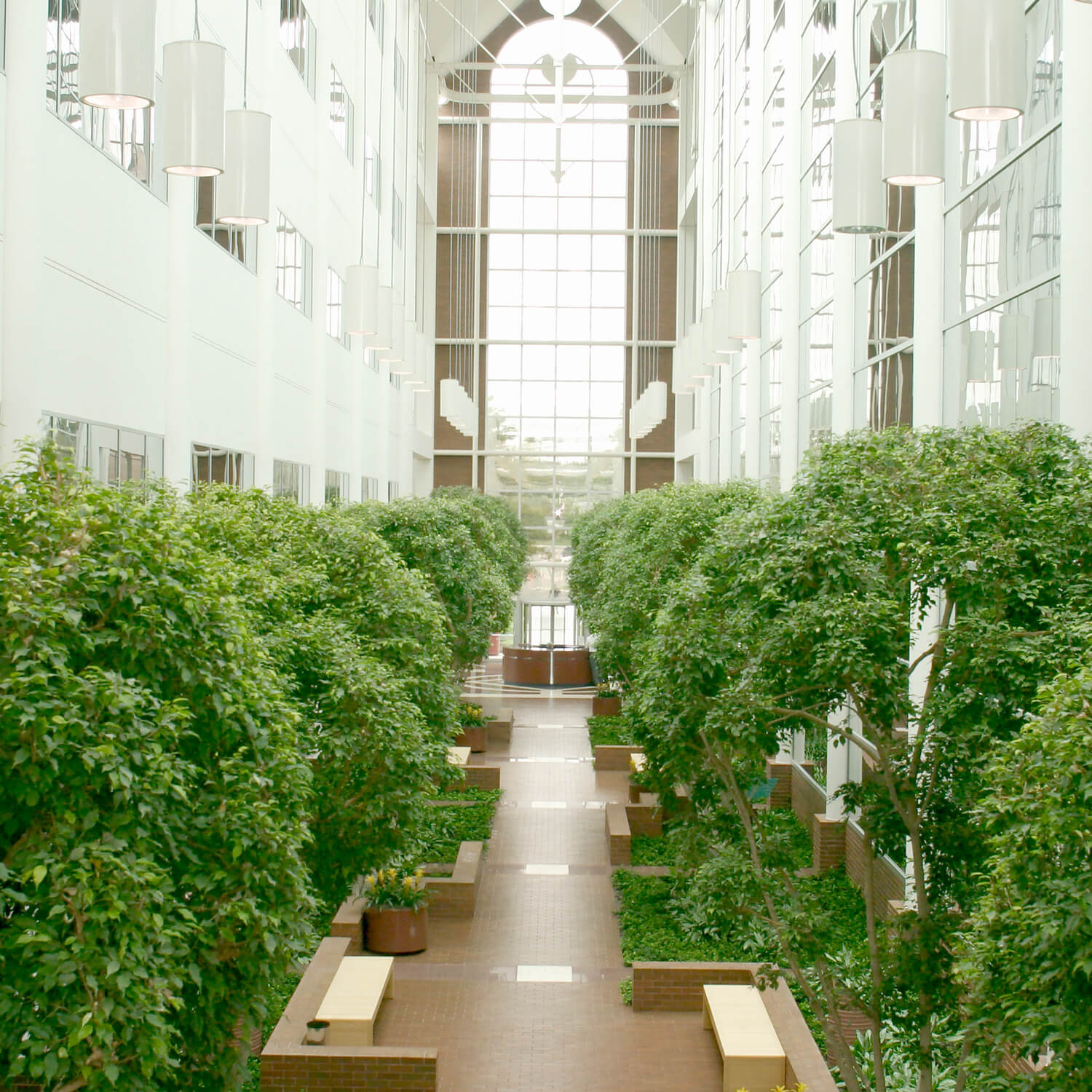Ficus Myths Debunked

Some people love the trees and others dislike them, especially those that haven’t been sufficiently maintained over the years. In our Q&A we ask Larry Pliska, Planterra’s founder, about the issues, concerns and myths surrounding ficus trees.
Q: Are Ficus trees dated relics of the 70s and 80s?
A: First of all, it is propitious to assume any tree or plant is out of date or dated. While plants and some varieties of plants are popular during certain eras, it is important to recognize that a plant is a natural, living, breathing organism that evolved over millions of years. Just like people, a certain hairstyle might be more popular in one season, but an attractive person will be attractive with any hairstyle. I admit that even the most attractive tree will look dated when surrounded by mauve and brass accents from the 1980s, but when someone says a tree is dated, they are confusing the tree as a fixture. A tree is not a fixture; it is a living feature, an element of nature that was brought inside a building to benefit the occupants.
Ficus trees are very much in fashion. Take one look at Instagram feeds from around the world and you’ll see that these trees are trending. The bigger challenge is procuring tall ficus trees. Nearly all the original Florida growers have sold their landholdings for development, but we still have ways to procure large-scale acclimated tropical trees.
Q: What about those “Charlie Brown” ficus trees? The ones that look neglected?
A: If the tree is taller than 10 feet and the truck has a caliper that exceeds 5 inches in diameter, it’s worth having the tree evaluated by an expert. By expert, I am referring to an interior landscape contractor who has a track recorded maintaining and pruning ficus trees. Pruning is very important. For contractors who don’t have an interior arborist on staff, they simply don’t provide this service - and won’t tell you about it. We have arborists on staff at Planterra. In many cases, proper and strategic pruning to promote new growth can transform the appearance of ficus trees. There are seasonal considerations for this to be successful and, of course, the key ingredient is light. The good news? Many old atriums have good light.
Even if the likely success of reshaping a ficus tree back to good health is marginal, it is important to consider the cost in replacing the tree with something new. When it comes to indoor trees, whether it’s a live plant or a replica, height and canopy size come at a premium. Think twice before cutting down a big tree - you can’t undo that action. Removing a big tree changes the space and, in some cases, renders the original purpose of the atrium useless. It may no longer feel like a place of respite.
Q: Is pruning always included with a horticulture maintenance contract?
A: The answer is no and that’s one reason why there are so many neglected ficus trees out there. When buildings change owners, when contracts are bid-out in lean times, when a contractor’s terms and conditions are revised, the pruning services are sometimes omitted to save on maintenance costs. If you have big trees that require pruning, we recommend the pruning have its own line item on your maintenance bill. Large ficus trees should be pruned once per year.
The other reason why a tree isn’t being properly pruned may be because your maintenance contract was never reviewed or updated as your tree grew from small to large. When ficus are first planted, very little pruning is usually necessary. If your building has a ficus tree that is more than a decade old, and you wish to keep it, a pruning service is recommended.
Q: The ficus outgrew my space. What do I do with an overgrown ficus?
A: Unlike palms, ficus can be pruned. Think of an indoor ficus tree like a very large bonsai, you can prune the tree to maintain a specific height and shape for the lifespan of the building. Ficus that have outgrown a space weren’t pruned. Annual pruning will prevent overgrowth.
Ficus will re-grow canopies after being severely pruned or topped. The success of re-growth depends on the light conditions and your willingness to wait for the re-growth to occur. There are creative ways to dress up a tree while its re-growing a canopy. For example, at botanical gardens they will nest bromeliads and ferns in the trunks, making it look like a new feature.

Q: Old trees can’t survive a renovation, can they?
A: They can. This requires planning. Old ficus trees can be saved in renovations but it depends on a lot of factors. The best advice is to involve an interior landscape expert early in the process. If the renovations are major, it is critical to protect the trees from excessive dust to prevent outages of natural light. Be sure to maintain the temperature so the trees you want to save don’t freeze or cook in extreme temperatures. Planterra provides design and consulting services on atrium renovations.
Q: How much is my old ficus tree worth?
A: If you have mature, well-maintained and healthy trees, the value is considerably high. To put a price tag on the trees, you first must consider the replacement value. This includes replacing it with another tree of the same size and the labor in today’s dollars to install it. If you are considering going with faux plants or replica trees, be aware that commercial grade artificial trees cost a minimum of four times more than live ones. With a horticulture care program, live trees last even longer than replica trees.
Larry Pliska is the founder of Planterra Corporation a nationally-known interior landscaping business that provides and maintains office plants for corporate spaces. He and his family also own the Planterra Conservatory, an award-winning botanical garden wedding and event venue in West Bloomfield, Michigan. Larry is available as an expert consultant on atrium designs and renovation projects in North America.
